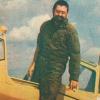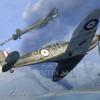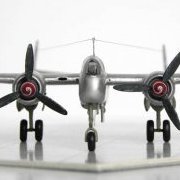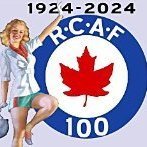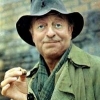Search the Community
Showing results for tags 'africa'.
-
As we all know, it is not particularly difficult to find photos of the prototype for a nice Bf 109E-4 or E-7 model from Africa. But if my memory serves me correctly, for several weeks in May, Gruppe III/JG27 operated from Sicily over Malta, flying not only Bf 109E-3s, but even E-1s. Of course, before III/JG27 arrived in Libya in December 1941, it had managed to complete a 4-month combat tour on the Eastern Front and was re-equipped with the Bf 109F, which reduces the chances of finding a Bf 109E-3 from this group in Africa to zero. But at the same time as the 3rd group was transferred to Sicily, the I/JG27 group was transferred to Gazala in Libya. So are there any chances of finding "early" (with a hollow spinner and old canopy) Bf 109E fighting over Africa? Maybe someone somewhere has ever seen a photo of a Bf 109E-1 (or at least an E-3) on African soil? Cheers Michael
-
I've built Crusader III & Flak 88 previously and combined them into one dio to make some battle scene. Here are the photos And some not photoshopped ones: Thanks for viewing 😉
-

Land Rover Safari - Masai Mara, Kenya
Slackbladder posted a topic in Ready For Inspection - Dioramas
Finally I would like to invite you all on safari in the Masai Mara, so jump aboard the Land Rover and enjoy... Isn't it amazing where those SAS guys pop up when you least expect them. Thanks for looking in, hope you enjoyed the trip. Many thanks to all who have followed from the start and for all your likes and comments.- 8 replies
-
- 27
-

-
- Land Rover
- africa
-
(and 1 more)
Tagged with:
-
As the title suggests the aim of this diorama is to re-create the plains of Kenya, so the challenge begins to turn this: into this minus the zebra. First stage is to add a small degree of contour so the base isn't totally flat, some ready mixed wall filler later and... add some wire trees... Position of the fallen tree is subject to change, it may migrate towards the right side. A layer of sandstone masonry paint mixed with a little white glue next. and then the first layer of fine sand. Some old Bestial brown Citadel paint, desert sand pigment, white glue and water mix seals the sand on and get us a nice red/brown base colour. After a dry brush of Tamiya Desert Yellow. Starting a look a bit dustier. Another dry brush later, this time with Tamiya buff (using up some of the left over paint from all those LRDG vehicles and bases 🙂) and we have: Now we can move onto the more exciting part of adding some colour and life to the scene with the first run of fine flock. Zoom in, we could be flying over the plains. Eye level views. That's as far as I've got today. Some longer grass, bushes, etc to be added, but I think it's a fair likeness for the original photo.....minus the zebra of course! Updates to follow...
-
This is the start of my Land Rover safari conversion to go on the Kenyan plains base I have created in the diorama section. Now, having looked at a couple of other Land Rover builds on here and 'THANKS' to Natter and Hairtrigger the first job I had was fairly fiddly as they pointed out a problem with the Italeri kit having six stud wheels. I would have been perfectly oblivious otherwise, not being a Land Rover nerd and all, but being a bit of a perfectionist and not wanting to spend upwards of another £20 to buy a set of wheels with the correct five studs I decided to just slice my nuts off and replace them. Sounds painful I know, but I am of course referring to the wheel nuts on the kit. Hopefully once primed, painted and weathered, any visible scars from the operation will be concealed. Another forum member had already performed this task in another build so it seemed that it should be doable. And the results are in, my wheels now have five studs as seen below. Thanks for popping in. Very early stages but I will update as progress continues. The nearly completed scene for the diorama can be found here,
- 17 replies
-
- 6
-

-
- Land Rover 1/35
- africa
-
(and 1 more)
Tagged with:
-
I offer this for Ready For Inspection. This was made during lockdown. Hand painted with acrylics. It was a nicely moulded kit and I thoroughly enjoyed the process. Yes it has some mistakes.. mucked the decals up a bit but .. I hope the finished result is not too bad.any comments will be graciously recieved and noted. I was out of the box and I rather liked the Desert paint cheme. I did a bit of weathering on it with my own washes and graphite pencils. I Enjoy! https://flic.kr/p/2jr9htA I offer an apology as initially i posted this with a 'Pics to follow' comment. This was because i couldn't get to my Fickr account logged on.
- 25 replies
-
- 2
-

-
- Airfix
- ww2 German
-
(and 1 more)
Tagged with:
-
Dear Forumites I'm almost 100% sure that similar question has occured before but UG hasn't help me with it. That's why I decided to ask it here as there are lots of people who have huge knowledge about Spitfires. I have a question about famous "custom" dust filters made by MU in Abou Kir/Abukir. Are there any existing drawings or detail photos? Until recently I thought that there was only one type but my friend, who is currently working on I.R. Gleed's Spitfire Mk.Vb from Africa has told me that there's something "wrong" with Gleed's Spit filter. I've looked at the photos taken during the session with No 601 sqn and noticed that he's right. Abukir filters on "The Winged Sword" Spits have different shape from Gleed's Spitfire. Later I've checked my books about Spitfires and found that there were, at least, two types... 1. Bulbous intake part and very thin aft part of the filter (as per 601 sqn Spits) 2. Bulbous intake part and wider aft part which looks as if they just modified the front part of Vokes filoter leaving the aft part without changes. Thank you for any help. Cheers! Dominik
-
Hello! Here is my Fairy Kikaku 1:144 scale resin kit of the Breda Ba.65 A80 which I completed in 2017. It represents 159-17 of 12º Gruppo, 159ª Squadriglia, Regia Aeronautica, North Africa, 1940-41. It was quite a challange turning the lumps of resin into something resembling the Breda. The real make-or-break part of this kit was turning the ceiling fan that came in the bag into a propeller and one of my greatest satisfactions of this build. A couple of details were scratchbuilt from sprue. The kit was fully painted and varnished by brush. I managed to replace most of the awful decals and touched up those I had to use with paint. My only regret was that the only option offered wasn't one of the more attractive schemes but decals for Italian aircraft in this scale are hard to come by (and I can't make my own). Many thanks for looking and comments are welcome Miguel
-
Showdown in Western Sahara Air warfare over the last African Colony - Africa @ War No.31 ISBN : 9781912390359 Helion & Company via Casemate UK Spanish Sahara and became one of Spain's last African Colonies. What is now Western Sahara was ruled by Spain from 1884 to 1975, becoming The Last African colony as by then all western powers had divested themselves of former African colonies. Following international pressure and more combat than has been reported Spain finally withdrew in 1975. Also at this time in the region complicate things there was the war between the former French colonies of Algeria and Morocco. Conflict was often miss reported as Soviet backed insurgents fighting Western Backed governments, but as is usually the case it was not as cut ad dried as this. Certainly there was an element of this though there continues to be issues in the region to this day with repression of some elements of the native population in Morocco causing large refugee camps in Algeria. Such was the research made (though not all-encompassing that the initial single volume will be split into two. This first one deals mainly with Air Operations from 1945 to 1975 and brings forward some interesting Aircraft. The Spanish Air force until late we still using predominately German designs of the Bf 109, Ju 52 and He 111, with these being the last combat operations for many of these types. Them later being replaced by F-5s and even F-104s. Morocco as well as using ex French types such as the T-28, were using US Supplied F-5As and even Soviet supplied MiG-17s. Algeria were also flying MiG-15, 17s, and MiG-21F-13's. As well as the Air War ground operations are also looked where again equipment ranged fro ex WWII M2 halftrack to more modern French Panhard EBTs and AMX-13s. The book is A4 softcover in format and 64 pages long, It is illustrate throughout with black and white photos. There one page of colour maps, five pages of colour aircraft profiles, and two pages of colour aircraft photos. Conclusion This book will give the reader an understanding of conflict in the area, and the forces which took part in one of the last throws of western colonisation. Highly Recommended. Review sample courtesy of
-
"Africa" Messerschmitt Bf 109F-4 & Bf 109G-2 Combo 1:48 Eduard Limited Edition The Messerschmidt Bf 109 is one of the iconic aircraft of WWII. The F-4 would use the 1332hp DB601E engine which would be fitted with a broader balded propeller for improved altitude performance. The aircraft would carry the new Mauser MG151 20mm cannon with 200 rounds per gun. Production of the F-4 would start in May 1941 and last a year with 1841 examples being built, 576 of these being the tropicalised version. The G variant of the 109, colloquially known as the Gustav was one of the primary fighters available to the Luftwaffe during the closing years of WWII, and saw extensive active service, all the while being upgraded to combat the increasing Allied superiority in the air. Happily for the Allies, the supply of experienced pilots was fast running out, so as good as the upgrades were, they couldn't make an appreciable difference to the outcome. The G-2 differed from the initial G-1 insofar as it eschewed the pressurised cockpit, and it was sometimes fitted with different head armour for the pilot The Kit We have previously reviewed the profipack boxing of the F-4 and the G-2, so will point you to those reviews if you want to see whats in the box here. This duel boxing contains one of each kit of the F-4, and The G-4 with the masks and photoetch you find in the profipack kits. In addition in this box you get some resin tropical filters and an impressive decal sheet. Decals This really is the main reason to get this boxing. The decal sheet is by Cartograf so quality is a given. There is a main sheet and stencils all in one, markings are provided for an impressive 12 examples; Bf 109F-4/Trop, W. Nr. 10137, flown by Oblt. Hans-Joachim Marseille, CO of 3./ JG 27, Ain-el-Gazala, Libya, June 1942 Bf 109F-4/Trop, W. Nr. 8673, flown by Hptm. Hans-Joachim Marseille, CO of 3./ JG 27, Quotaifiya, Egypt, September 1942 Bf 109F-4/Trop, flown by Hptm. Eduard Neumann, CO of I./ JG 27, Martuba, Libya, December 1941 Bf 109F-4/Trop, W. Nr. 10154, flown by Lt. Friedrich Körner, 2./ JG 27, Ain-el-Gazala, Libya, June 1942 Bf 109F-4/Trop, W. Nr. 8438, 4./ JG 27, El Gazala, Libya, end of 1941 Bf 109F-4/Trop, W. Nr. 8596, flown by Ofw. Erwin Sawallisch, 4./ JG 27, Quotaifiya, Egypt, August 1942 Bf 109F-4/Trop, flown by Lt. Jürgen Harder, 7./ JG 53, Martuba, Libya, June 1942 Bf 109G-2, flown by Fw. Anton Hafner, 4./ JG 51, Bizerta, Tunisia, November 1942 Bf 109G-2/R1, W. Nr. 10805, flown by Lt. Wilhelm Crinius, 3./ JG 53, Bizerta, Tunisia, January 1943 Bf 109G-2/Trop, flown by Hptm. Heinrich Bär, CO of I./ JG 77, North Africa, 1942 – 1943 Bf 109G-2/Trop, 2./ JG 77, North Africa, autumn 1942 Bf 109G-2/trop, W. Nr. 10533, flown by Uffz. Horst Schlick, 1./ JG 77, Bir-el-Abd, Egypt, November 1942 Conclusion This is a welcome release from Eduard for those who like the Mediteranean Theatre, or the avid 109 fan.. Not only do you get two ProfiPACKs but extra parts for the tropicalised machines, and a great selection of decals. If you want to make use of more of the schemes then overtrees are also available for the extra kits. Highly recommended. Africa Dual Combo F-4 Overtrees G-2 Overtrees Review sample courtesy of
-
In May of 1942, JG 27 had a 4th Staffel attached to it's third group to perform exclusively in the fighter-bomber (Jabo) role. Depending on the source, I find the aircraft listed either as the 109-E4B or E7B? This unit only lasted about 3-4 months when III.Gruppe relinquished it's control, and it became part of JaboGruppe Afrika. Any ideas of how these aircraft might have been marked up? I'm thinking it was typical Luftwaffe tropical scheme, with aircraft number possibly in blue (Staffel colour) on the engine cowl, and the wavy style Gruppe marking also in blue. Gruppe emblem (shield graphic linked below), would be in front and below the cockpit window. Not sure about a bomb symbol. Thoughts from the members? regards, Jack
-
Ju-88A-11 1:48 ICM (48235) The Ju-88 was designed as a schnellbomber in the mid 30s, and at the time it was faster than current fighter designs, so it was projected that it could infiltrate, bomb and exfiltrate without being intercepted. That was the theory anyway. By the time WWII began in the west, fighters had caught up with the previously untouchable speed of the 88, and it needed escorting to protect it from its Merlin equipped opponents. It turned out to be a jack of all trades however, and was as competent as a night fighter, dive bomber or doing reconnaissance as it was bombing Britain. They even popped a big gun on the nose and sent it against tanks and bombers, with variable success. The A series sported a pair of Jumo 211 engines in cylindrical cowlings producing over 1,000hp each, and was improved gradually up until the A-17, with the A-11 being the official designation for the factory produced tropicalized version. It was fitted with filters to protect the engine from dust and dirt, as well as a rescue kit for ditching and forced landings. The Kit This is a new variation on the original tooling of an A-5 that was release recently by ICM, with new parts added to make it version specific. There are new engine nacelles and props; new fin and rudder; changes to the cockpit mounted machine-guns, and different glazing options are chosen from the same clear sprue. The box is the usual top-opening with an inner lid style, and inside you will find eight sprues in grey styrene, one in clear, decal sheet and a glossy covered instruction booklet with spot colour inside, and the decal options in full colour on the back cover. If you have been lucky enough to see the A-5, you'll know that detail is right up there in terms of quality and crispness, with ICM really improving over the last few years, which has to be great news for modellers, as they aren't frightened of tackling what to us may seem niche subject matters. With the sprue-related excitement out of the way, work on the fuselage begins with the addition of sidewall details in the capacious cockpit area. Rear bulkhead, side consoles and seats are all added to the cockpit sides for a change, with an insert in the fuselage for the circular antenna and tail wheel added into the starboard side. The instrument panel is supplied with decals, and fits into the fuselage during joining. The missing floor is added to the lower fuselage panel that includes the lower parts of the inner wings and gives the structure some strength. It also receives the rudder pedals, control column, and the two remaining crew seats before being joined to the fuselage. The tail plane has articulated flying surfaces, and the wings are supplied as top and bottom, with the flaps and ailerons separate from the box, and neat curved fairings so they look good when fitted at an angle. The flaps include the rear section of the soon-to-be-fitted nacelles, which are added as separate parts to avoid sink-marks, and these and the ailerons run full-span, terminating just as the wingtip begins. This variant was fitted with the under-fuselage gondola, and each side has separate glazing panels inserted from inside, and a seam running vertically through its length. It is added to the hole in the underside of the fuselage, with the front and rear glazing plus zwilling mounted machine guns later in the build. At this time the landing gear is made up on a pair of upstands that are added to the underwing in preparation for the installation of the nacelle cowlings. The engines have to be built up first though, consisting of a high part count with plenty of detail, and a rear firewall that securely fits inside the cowling. Even though this is an in-line engine with a V-shaped piston layout, the addition of the annular radiators gives it the look of a radial, with their representation added to the front of the cowling, obscuring much of the engine detail. The side panels can be left off to show all that detail however, and I'm sure Eduard will be along with some in-scale opened panels in due course (there might be some in my inbox, thinking about it!). The cooling flaps around the cowling are separate, and the exhausts have separate stacks, which aren't hollow but are large enough to make boring them out with a drill a possibility. The completed nacelle fit to the underwing over the top of the main gear installation, securing in place with four pegs, two on each side of each nacelle. The props are made from spinner, backplate and a single piece containing all three blades, sliding onto a pin projecting from the engine front, which will require some glue if you want to keep them on. At this point the instructions recommend adding the canopy glazing, which consists of a choice of two faceted nose cones, and the main greenhouse for the cockpit aperture. The rear portion is made from two additional parts due to its double "blown" shape to accommodate the two rearward gun positions, so that the gunner's head isn't pressed against the canopy. The guns are fitted through the windscreen and the two circular ports on the rear, although no ammo feed is supplied. Under the wings the dive spoilers are added with four bomb crutches on aerodynamic mounts, with bombs supplied that have two of their fins moulded separately, along with the stabilising struts that fit into notches in the fins. While the airframe is flipped over, the two-part wheels and twin main gear bay doors are added, both having good detail and the former a radial tread. Addition of the canopy mounted antenna completes the build, but this is likely to be done long after main painting for safety's sake! Markings The kit includes two markings options from the relevant theatre, and the first page of the painting section details the application of the numerous stencils that are supplied in the kit. There are no Swastikas on the sheet, but the Balkenkreuz are included, with a portion separated into narrow sections to ease decaling the dive spoilers. From the box you can build one of the following: Junkers Ju.88A-11 3./LG 1, North Afrika, 1942 – Afrika Brown over Hellblau RLM 65 Junkers Ju.88A-11 I./LG 1, North Afrika, 1942 – Afrika Brown with Dunkelgrun RLM 71 patches over Hellblau RLM 65 The colours are picked out using letters that correspond to a table on the front page, which gives the names and paint codes in Revell and Tamiya ranges, so should be easy to convert to your paint system of choice. The decals are printed in-house and have good register, colour density and sharpness, with additional instrument dials included on a clear carrier film to help with cockpit painting. All of the stencils are legible, and overall they inspire confidence, with a thin carrier film cut close to the printing, with a few exceptions where lettering has film that could have been dispensed with to reduce the menace of silvering. Conclusion ICM's range of Ju.88s and Do.17s are a good example of how far they have come in recent years, adding value to their brand, and improving their reputation with each release. The kit is well-detailed and comprehensive in what it includes, and with a nice pair of decal options it says "build me". Highly recommended. Review sample courtesy of
-
Here is another one I've made after Messerschmitt. It's Spitfire Mk IXc from Polish Fighting Team (also known as Skalski's Circus). I decided that brush painting does not give me satisfying results so I've purchased an airbrush / compressor set. Model has been preshaded with black dry pastel (I found this method better for me than airbrushing along panel lines). It was then airbrushed with Vallejo Air paints. It was my first airbrush job ever and I had to do it twice on the bottom because I've applied too many layers and preshading disappeared. I've preshaded it again and painted it once more. Finally it was weathered with pastels. Again, some Photoshop work on diorama blending with background applied. Hope you like it
- 31 replies
-
- 48
-

-
Hi all, I am considering building a B-25 Mitchell and would like to finish it as an aircraft that was based in either North Africa or the Mediterranean. Whilst looking through my references and trawling the internet I keep coming across profiles of aircraft which are painted in a disruptive upper surface camo of sand and green which I really like, the only problem is that I cannot find a single photograph to back any of these schemes up and I don't want to build something in a spurious scheme. I was wondering if any of you could either point me in the right direction or disprove these schemes once and for all, either way I will be happy as there are other schemes I could use. Thanks in advance. Craig.
-
Okay then here goes with number 2!! I have decided that despite having another build on the go that I have to make a start on this one. I will be using the Hobby Boss Mig-17F with a replacement ejector sear from Neomega. The decals are from a Carpena sheet and the Zotz roundels of the world sheet covering Southern Africa. Other than the seat this will be pretty much OOTB. Thanks to some info supplied by Tom Cooper (thanks Tom) I will be finishing it in the colours worn by ex-East German Air Force aircraft that they supplied to Mozambique, that is green and brown upper-surfaces with a pale blue underneath. Below are the usual kit and other stuff photos to show what I will be using. Thanks for looking, and I hope you enjoy the build. Craig.
- 91 replies
-
- 7
-

-
- Mozambique
- Mig
-
(and 1 more)
Tagged with:
-
Figured I'd go ahead and start this thread even though the kit won't be arriving until Tuesday. I've noticed all of the resin aftermarket parts for the Il-28 are for the Italeri kit, but I had ordered the Trumpeter kit already and it was cheap enough that I'm not worried about super-detailing. The markings will be from a NOS ESCI 1/72 sheet of Sudan (pre-60s), Somalia, Nicaragua, Guatemala, Honduras, and Cuba "national insignias" (roundels and flag tail markings). Now on to the other issues - every Il-28 kit in existence, from what I've read, is problematic. I think I'll be able to build it successfully, but references on this aircraft are fairly poor from what I've seen. The main discussions are about the Soviet version or the Chinese Harbin H-5, and most pictures are either Soviet or Polish. The Trumpeter kit comes with decals and a painting guide for the PLAAF, and I believe the VPAF, which is a green upper and grey lower surfaces scheme. I honestly think the only difference between the Il-28 kit and the Harbin H-5 kit is the box art. This is definitely not the scheme of the Somali Air Force in the 1970s. Every other operator seems to run either NMF or a grey scheme. This Romanian example is pretty wild - Which leads to the main issue - I have no references for how to paint this aircraft at all. I can apply the markings without much difficulty (excluding the serial number), but roundels and tail markings are pretty much universal in their placement. I have found this video - https://www.youtube.com/watch?v=ftofj4wsFvY - but it's of very poor quality and does not appear to show any Il-28s. I have been unable to find a single photo of a Somali example so far. If Mr. Cooper has any input on this (I know it's not a MiG or Sukhoi, though), I would be most grateful. The only other images I found besides pictures of Soviet Bloc examples were these hand drawings of the cockpit and navigator's position. Any ideas? I'm thinking they probably flew them as they were painted on delivery, which would be the Soviet scheme (right?). I'm a little hesitant to try doing NMF on my second aircraft. I feel like I need a lot more practice before I try that. Likely to end up a neutral grey underside with a darker gloss grey upper surface. I feel like I've seen Polish examples of that. Still, painting is a long, long way off.

